Usually it’s a little difficult to bring oneself to do a lot of elaborate baking shenanigans in the summertime in New York, what with the humidity and the stickiness and the death by sweating and such. But seeing as how it’s basically been raining for two straight months (making us city dwellers feel like we’ve somehow been transported to the opposite coast), there’s been plenty of sleepy, cool baking weather to go around. All of which turned out to be quite convenient when I decided to bake a very elaborate and time consuming cake for Father’s Day (I realize this was two weeks ago; I’ve been busy… with stuff).
Bavarian cakes are generally done with either genoise or chiffon as a base, both of which are relatively light and unassuming, thus making them a good straight man (straight cake?) for all the fruity wonder that goes on. Your basic Bavarian consists of several layers: a bottom layer of cake covered with a fruit puree; a layer of Bavarian cream; a layer of fruit (one or several types, depending on your preference/what’s in season); yet another layer of cream topped with another layer of puree; a second layer of cake; and a very slightly sweetened whipped cream topping. The component parts are relatively simple, but the production takes a good long while because each of the parts are prepared separately and cooled before the cake is assembled. I went with another outstanding Tartine recipe for this guy. You’ve probably noticed that I use their recipes a lot, so I’ll come right out and say that I’m pretty smitten with them. They are, quite simply, a win.
preparation.
The cake adventure started on Saturday morning, when Kenan and I got an early start on the farmer’s market, where we purchased fresh, delicious strawberries, after which we went to the Garden for the rest of the fruit (raspberries and peaches of several varieties). Then it was back to the apartment to prepare the pastry cream. I always get a little nervous when making pastry cream that I’ll cook it too long and cause it to curdle. But this time it went very quickly and smoothly, I think owing at least partially to the fact that I’ve finally convinced myself that it’s worth it to measure and set out all my ingredients before hand. I mean, I knew it was good practice, but I’d never really had the patience to do it before. Then I set that up to cool while I dealt with the cake.
I really wanted to make a genoise for the cake foundation, as the ingredients are so simple and the result is, I think, a perfect base for this type of dessert. However, I didn’t have a heatproof bowl that was big enough for all the batter, so I went with a chiffon instead. Chiffons tend to be a bit too far to the angel food side of the cake arena (sticky, fluffy, etc.) for my taste, but that’s not to imply that they aren’t a great alternative to a genoise. They’re easier to make, and produce an airy texture that’s quite pleasing. At any rate, I had a mini-freakout during the batter process because I initially forgot to add water, but I was able to correct the error, and in the end the cake came out of the oven like a champion; it had risen up and out of the 3-inch deep pan, and it was moist, airy and golden.
After waiting for the cake to cool down entirely and then cutting it in half, which is actually a bit more of a trick than it sounds (it’s very wide and thick, and you kinda have to saw through it like it’s a big tree), I cleaned the pan out, lined the sides with plastic wrap (prevents the filling and fruit from sticking to the sides of the pan) and then placed the bottom layer of the cake in the pan. This bottom layer is then coated with a simple fruit puree, for which I used a combination of raspberries and golden raspberries and a touch of brandy. Then it was time to make Bavarian cream. This involves heating a small amount of pastry cream with gelatin – it’s a bit wonky, but it makes the filling stand up heartily under the weight of the cake and fruit – and then adding that concoction back into the rest of the pastry cream. Then you whip up some heavy cream and gently fold that in and quickly spoon half of it onto the bottom layer of the cake. Next comes a generous helping of fresh fruit, for which I used white peaches, saturn peaches, raspberries, golden raspberries, and strawberries. I then made a slight mistake: before adding the rest of the bavarian cream and then the fruit puree, as you’re supposed to, I put the rest of the batch of fruit puree on top of the fresh fruit. Because of that, I didn’t have any more puree to put on top of the cream and thus soak into the top layer of cake, which meant I had to make another batch of puree. It was a bit of a happy accident, however, as the extra puree made for yet another layer of fruity fun – it was just lucky for me that I had enough fruit left over to do that. And so, after the hoo hah, it was time to cover the cake up with the plastic wrap and put it to sleep for the night (or for three hours, at the very least).
hanging out, eating cake.
I let the prepped cake hang out in the fridge on Sunday while we gallivanted. There was bowling, delicious egg salad at lunch, an interlude of inside time with books and video games owing the rain, a rousing game of Calvin Ball in Central Park, and a dinner so great that it really proved quite the trick to save enough room for cake.
Before serving, the cake comes out of the pan and gets unwrapped and topped with a layer of whipped cream. And then, savoring the end of one of the first beautiful days of summer (despite the brief rain), we ate the crap out of that thing.
make it.
pastry cream**
| whole milk | 2 cups |
| vanilla bean | 1/2 bean |
| salt | 1/4 teaspoon |
| cornstarch | 3 tbsp |
| sugar | 1/2 cup + 1 tbsp |
| large eggs | 2 |
| unsalted butter | 4 tbsp |
Have a bowl ready for cooling the pastry cream with a fine-mesh sieve resting in the rim.
Pour the milk into a heavy saucepan. Split the half vanilla bean lengthwise and use the tip of a knife to scrape the seeds into the milk. Add the salt, place over medium-high heat, and bring to just under a boil, stirring occasionally to make sure that milk solids are not sticking to the bottom of the pan.
Meanwhile, in a mixing bowl, whisk together the cornstarch and sugar. Add the eggs and whisk until smooth.
When the milk is ready, slowly ladle about one-third of the hot milk into the egg mixture, whisking constantly so that the eggs don’t curdle. Pour the egg-milk mixture back into the hot milk in the pan and continue whisking over medium heat until the custard is as thick as lightly whipped cream, about 2 minutes. In order for the cornstarch to cook and thicken fully, the mixture must come to just under the boiling point (you’ll see a few slow bubbles), but not to a full boil, as this will curdle the mixture. Remove from heat and pour immediately through the sieve into the prepared bowl. Let cool for 10 minutes, stirring occasionally to release heat and prevent a skin from forming.
Cut the butter into 1 tablespoon pieces. When the pastry cream is ready (about 140 degrees), whisk the butter into the pastry cream 1 tablespoon at a time, whisking until smooth before adding the next bit.
To cool the cream, cover the bowl with plastic wrap, pressing the wrap directly onto the top of the cream to prevent a skin from forming on the surface. Don’t over-whisk once it is cooled, as this breaks down the starch and thins the cream.
**Notes: (1) Never use an aluminum pan to make pastry cream, as it reacts with the yolks and turns the cream gray.
(2) Have a lightly dampened kitchen towel or handy assistant at the ready so the eggs are stabilized while you pour the milk in and whisk at the same time (in the towel scenario, place the towel under the bowl before you start the whisking).
chiffon cake
| all-purpose flour | 2 1/4 cups |
| baking powder | 2 tbsp |
| sugar | 1 1/2 cups |
| vegetable oil such as safflower or sunflower | 1/2 cup |
| large egg yolks | 6 |
| water | 1/4 cup |
| vanilla extract | 2 tsp |
| lemon zest, grated | 1 1/2 tsp |
| large egg whites | 10 |
| cream of tartar or lemon juice | 1/4 tsp |
Preheat the oven to 325 degrees. Line the bottom of a 10-inch springform pan with 3-inch sides with parchment paper cut to fit exactly. Do not grease the sides of the pan.
Sift together the flour and baking powder into a large mixing bowl. Add 1 1/4 cups of the sugar and the salt and whisk to combine. In a small bowl, whisk together the oil, egg yolks, water, vanilla and lemon zest. Make a well in the flour, add the yolk mixture, and whisk thoroughly for about 1 minute until very smooth.
Place the egg whites in a large mixing bowl. Using a mixer fitted with the whisk attachment, beat on medium speed until frothy. Add the cream or tartar or lemon juice and beat on medium-high speed until the whites hold soft peaks. Slowly add the remaining 1/4 cup of the sugar and beat until medium-high speed until the whites hold stiff, shiny peaks. Using a spatula, scoop about a third of the whites onto the yolk mixture and fold in gently. Gently fold in the remaining whites just until combined.
Pour the batter into the pan, smoothing the top with a spatula if necessary. Bake until a cake tester inserted in the center comes clean, 45 to 55 minutes. Let cool in the pan (the sides help the cake hold its structure). To unmolk, run a small knife around the edges of the pan to loosen and then release the pan sides. Invert the cake and peel off the parchment. To split the cake, use a long, serrated knife. Mark the desired thickness all the way around the cake. Holding the knife parallel to the surface and using a sawing motion, cut through that thing, making sure that the handle and the tip of the knife are level. If you aren’t using the layers straight away, cover them with plastic so they don’t dry out.
bavarian cream cake
| 10-inch chiffon | 1 |
| fresh fruit (one type or a mixture) | 2 pints of berries or cherries, or about 1 1/2 lbs peaches, apricots or nectarines |
Line the sides of a 10-inch springform pan with 3-inch sides with plastic wrap, allowing enough overhang to cover the top of the cake completely when it is assembled. Leave the bottom of the pan unlined.
If using berries, leave them whole (you’ll need to hull strawberries if using them). If using cherries, remove the stems and pits. If using peaches or nectarines, slice lengthwise into eighths; if apricots, pit them and slice into quarters. You’ll want a total of about 4 cups prepared fruit.
fruit puree
| berries | very full 1/2 pint |
| sugar | scant 1/4 cup |
| salt | pinch |
To make the puree, combine the berries, sugar and salt in a blender and process on high speed until smooth.
filling
| gelatin | 1 1/4 tsp (1/2 envelope) |
| water | 1 tbsp |
| pastry cream, cold | 2 1/2 cups (one batch) |
| heavy cream, very cold | 2 cups |
To make the filling, in a small dish, sprinkle the gelatin over the water and let stand for a few minutes to soften. Pour water to a depth of about 2 inches in a saucepan, place over medium heat, and bring to a simmer. Place 1/2 cup of the pastry cream in a heatproof, stainless steel bowl that will rest securely in the rim of a saucepan over, but not touching, the water. Heat the pastry cream, whisking constantly, until hot to touch (120 degrees), about 5 minutes. Add the gelatin and whisk until smooth. Remove from the water bath. Whisk half of the remaining cold pastry cream into the hot mixture, then whisk in the rest.
In a mixing bowl, using a mixer fitted with the whisk attachment or a whisk, whip the cream until it holds medium-stiff peaks. Immediately and gently fold the whipped cream into the pastry cream with a rubber spatula.
Fit 1 cake layer into the bottom of the prepared pan. Using a pastry brush, moisten the layer with half of the fruit pure. Spoon half of the filling onto the layer and add the fruit, and spoon the rest of the filling over the fruit. Smooth the surface with a spatula. Quickly turn the remaining filling onto the fruit, lightly pressing down with the back of a large spoon to eliminate air bubbles. Place the second cake layer on top and moisten it with the rest of the fruit puree. Fold the overhanging plastic wrap over the top of the cake, covering completely, and then gently press down on the plastic to distribute the cream evenly (don’t use too much pressure). Refrigerate at least 4 hours or overnight.
When ready to serve, release and lift of the sides of the pan and peel away the plastic wrap. Transfer to a serving platter using a wide metal spatula, or leave the cake on the pan base.
topping
| heavy cream, very cold | 1 1/4 cups |
| sugar | 3 tbsp |
To make the topping, using a mixer or whisk, whip the cream until thickened. Add the sugar and whip until the cream holds soft peaks. Using the offset spatula, frost the top of the cake. The cake can be served immediately or kept cold in the refrigerator for up to 3 days until ready to serve.
all photos by the wonderful boy blue






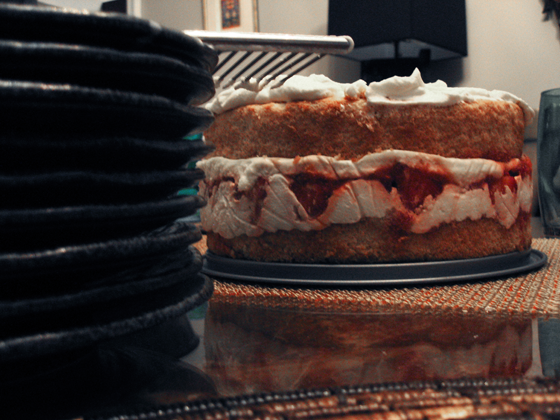
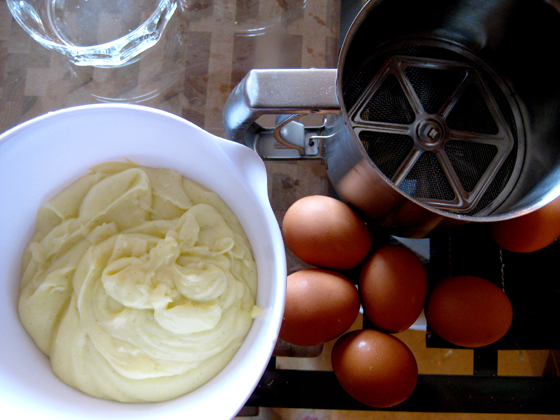
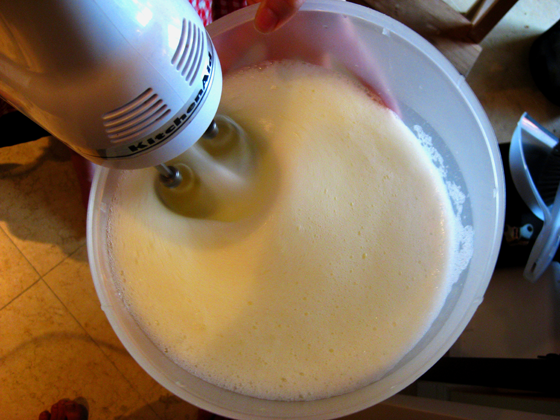
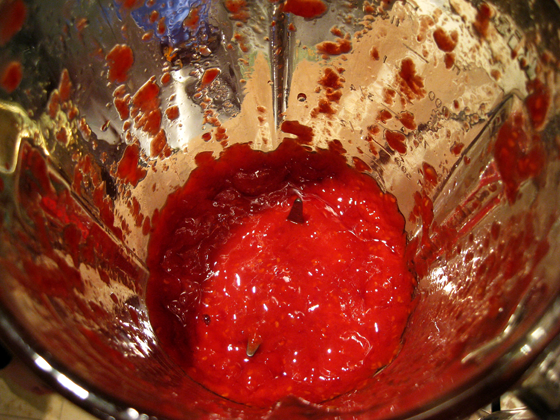
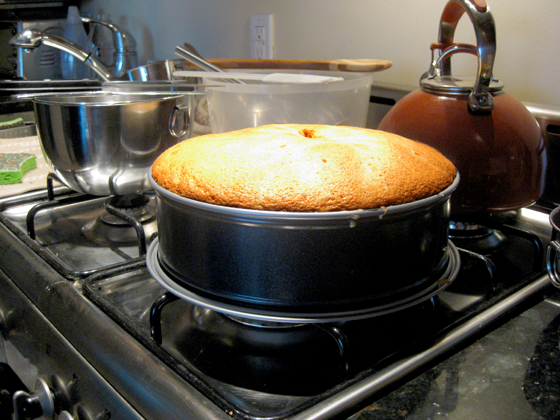
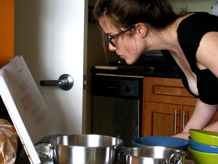



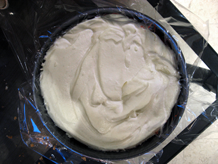
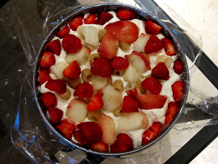

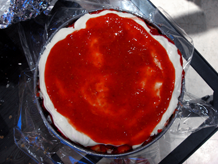


I will have to try that one. Perfect timing with seaiwbtrrres ripening in Oregon. I just made and delivered a fresh strawberry chiffon cake. Looked and smelled great. I’ve made a few other versions. I look forward to that one when you get to it. Thanks Rainey for the link!!
[…] I know I’ve used several of Tartine’s recipes before, but eating their amazing food when we were in California was so inspiring and […]